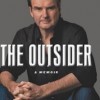By Cliff Richey
Have you ever wanted to meet Jimmy Connors?
No chance you say?
Then go buy his new book “The Outsider” available here: http://www.amazon.com/Outsider-Memoir-Jimmy-Connors/dp/0061242993/ref=sr_1_1?s=books&ie=UTF8&qid=1371565332&sr=1-1&keywords=The+Outsider It’s pure Connors. Plain and simple. Jimmy brings you into his world in a very Connors-like in-your-face fashion.
How would I know? Our relationship goes back over 40 years when I first met him as a high-school kid in the locker room at the West Side Tennis Club at Forest Hills at the 1970 US Open, when I reached the semifinals and he lost in the first round. We played for the first time two years later, Jimmy beating me a third-set tiebreaker in Los Angeles, and he won all four of our matches on the ATP Tour, but there was a mutual respect and friendship between us. I think Jimmy saw what a fighter and competitor I was and that, like him, I wasn’t part of the “stuffy crowd” in tennis. I was from a hard-working blue-collar family and me, and my tennis Hall of Fame-playing sister Nancy, were very independent. Like Jimmy, we had an “us-against the world” attitude.
Jimmy was a gutsy brawler. You’d want him in your bunker and if he is your friend, he goes the extra mile. Trust me. Jimmy was so supportive of my post-tennis efforts in mental health that he wrote the foreword to my book about my life overcoming depression called “Acing Depression: A Tennis Champion’s Toughest Match” available here: . http://www.amazon.com/Acing-Depression-Tennis-Champions-Toughest/dp/0942257669/ref=sr_1_1?s=books&ie=UTF8&qid=1371565359&sr=1-1&keywords=Acing+Depression
So, with that fully disclosed, I will tell you that “The Outsider” fully captures the essence of Jimmy Connors. This book lays out in good detail one of the most colorful tennis figures of all time.
In an era of fancy tennis academies and cookie cutter teaching and cookie cutter produced players “The Outsider” gives you an East St. Louis, skinny kid hitting balls on a makeshift gravel cement court and a backboard of plywood. Coached by his mother, Gloria, and his grandmother – dubbed “2Mom” – this recipe produced a five-time US Open champion. Throw in a couple Wimbledons and an Australian Open and, wow, what a career!.
We all knew Connors, America’s tennis bad boy, and fellow tennis icon Chris Evert, America’s Sweetheart, were engaged – and now readers know some of the details, which has caused controversy that many of you have probably read. Jimmy was often a controversial figure – and that continues today. Jimmy and Chris figured out that their relationship wouldn’t work, but it’s interesting reading. Jimmy then marries a Playboy Bunny, Patti McGuire. It looked like a reckless, low percentage play just like his playing style. Of course we now know his marriage is still a great love affair after 34 years. And his style of play is in the Hall of Fame.
Obsessive Compulsive Disorder and a gambling habit is all mixed in to a life story of controversy, fights against the authorities and rule-makers of tennis, bad behavior, and, oh yeah, 109 singles titles, more than any other man in pro tennis history. Connors tells of being brought up to not trust anybody. In the prim and proper world of tennis in the late 1960’s, that attitude rankled a lot of this so called establishment. Jimmy was also taught that winning was the checkmate to his critics. The establishment taught that winning was secondary to being a good sport! The Connors Clan had a different theory — a blue collar idea. Win big enough and long enough and the so called bad sportsmanship becomes “colorful.” I think they may be right but of course I’m a little biased!
I don’t want to give away too much information on the book but if you like down-to-earth stories mixed with action-packed great comebacks and, yes, heart breaking losses – I encourage you to buy it and put it on the top of your summer reading list.
Cliff Richey was known as the original “Bad Boy” of tennis. His career was highlighted by a 1970 season where he led the United States to the Davis Cup title, finished as the first-ever Grand Prix world points champion and won one of the most exciting matches in American tennis history that clinched the year-end No. 1 American ranking. He won both of his singles matches in the 5-0 U.S. victory over West Germany in the 1970 Davis Cup final, while he beat out rivals Rod Laver, Ken Rosewall, Arthur Ashe and Stan Smith to win the first-ever Grand Prix world points title the precursor to the modern day ATP rankings. At the 1970 Pacific Coast Championships at the Berkeley Tennis Club in Berkeley, Calif., he earned the No. 1 U.S. ranking when he beat Smith in a fifth-set tie-breaker, where both players had simultaneous match point in a sudden-death nine-point tie-breaker at 4-4. He also reached the semifinals at the 1970 French Open and the 1970 and 1972 and U.S. Opens. He and his sister Nancy, a former French and Australian singles champion, are regarded by some as the best brother-sister duo in tennis history.

